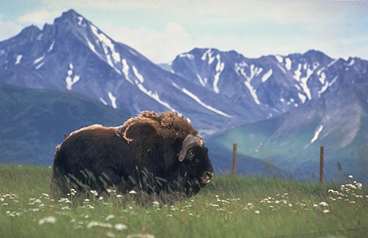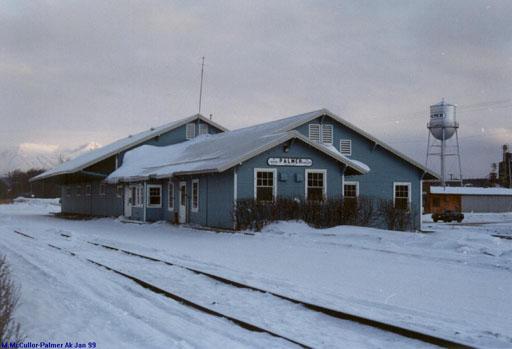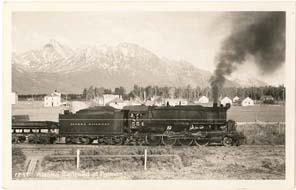Palmer
Six Mile Branchline from M.P. 150.7
Current Population: 5,937 (as of
2010)
Incorporation Type: Home
Rule City
Borough Located In: Matanuska-Susitna
Borough
Taxes: Sales: 3%; Property:
3.00 mills (City); 11.73 mills (Borough); 5% Accommodations Tax (Borough)
City: City of Palmer, 231
W. Evergreen Ave., Palmer, AK 99645, Phone 907-745-3271 , Fax 907-745-0930
Set between two distinct ranges
of towering, snowcapped mountains, Palmer began as a farming community
and served as a gateway to the Alaska interior for fur traders, trappers,
gold miners and those wanting to live life on the frontier. Palmer
is located in the center of the lush farmlands of the Matanuska Valley,
42 miles northeast of Anchorage on the Glenn Highway. Palmer was
established around 1916 as a railway station on the Matanuska Branch of
the Alaska Railroad.

In 1914, farmer John Bugge started
his farm where the intersection of the Palmer-Wasilla and Glenn Highways
are now. In 1935, Palmer became the site of one of the most unusual
experiments in American history: the Matanuska Valley Colony. The Federal
Emergency Relief Administration, one of the many New Deal relief agencies
created by President Roosevelt, planned an agricultural colony in Alaska.
203 families, mostly from Michigan, Wisconsin and Minnesota, were invited
to join the colony. They arrived in Palmer in the early summer of 1935.
Each family drew lots for their 40 acre tracts. Although the failure rate
was high, many of their descendants still live in the Mat-Su Valley today.
Many of the structures they built are now Historical Landmarks. To
this day, farming plays an important role in the Mat-Su Valley.
Palmer also served as a homesteading
area for miners who had returned from the Nelchina gold stampede
in 1913 to lead an agricultural lifestyle. Development of the coal mines
near North of Palmer at Sutton, Eska and Chickaloon, and the influx of
gold miners heading to Independence Mine in Hatcher Pass contributed to
the increase in population.
With the arrival of telephone and
electric utilities, the town became even better established. Palmer became
the center of economic activity by growing and processing agricultural
products and by building a local hospital.
The Alaska Railroad's first
streamline, the AuRoRa (#1050), made its first run to Palmer on October
16 with a train load of school children. On October 18, Alaska Day,
formal inauguration ceremonies were held at the depot in Anchorage, prior
to the inaugural run north. Bands played and the streamline was christened
the "Aurora."
Fortunes declined during the late
1960s and early 1970s when the coal mines closed and the creamery was moved
to Anchorage. Once serving as a direct connection between Anchorage and
Fairbanks for the Alaska Railroad, Palmer was entirely bypassed with the
rerouting of the Parks Highway.
The valley is renowned for the annual
Alaska State Fair, where local farmers produce award winning vegetables.
Best known are the incredibly large vegetables grown in the almost constant
summer sunlight, including 75 pound cabbages, ten pound onions and 125
pound pumpkins.
 Water
is provided by three deep wells, is treated and distributed throughout
Palmer. Sewage is collected by pipe and treated in an aerated lagoon facility.
The schools and Palmer Correctional Center operate individual well systems.
All homes are completely plumbed.
Water
is provided by three deep wells, is treated and distributed throughout
Palmer. Sewage is collected by pipe and treated in an aerated lagoon facility.
The schools and Palmer Correctional Center operate individual well systems.
All homes are completely plumbed.
Palmer's economy is based on a diversity
of retail and other services, and city, borough, state and federal government.
Some light manufacturing occurs. Many are employed in Anchorage. 73 area
residents hold commercial fishing permits. Palmer is home to 200
musk ox whose underwool (qiviut) is knitted into garments by Alaska Native
women from 12 rural villages. Between 2,500 and 3,500 garments are created
each year by these women, and sold by an Anchorage cooperative. The 75
acre musk ox farm is also a tourist attraction. About 70 percent
of all Alaskan grown agricultural products are grown in this area.
Palmer's rail spur leads six miles
south where it joins the main rail line at Matanuska. The main commodity
hauled by rail from Palmer is gravel which is critical to construction
projects.

The train depot is no longer being
used since newer tracks bypass Palmer.

Early photograph of the Alaska
Railroad in Palmer
Back
Page created 12/1/99 and last updated 12/2/11

 Water
is provided by three deep wells, is treated and distributed throughout
Palmer. Sewage is collected by pipe and treated in an aerated lagoon facility.
The schools and Palmer Correctional Center operate individual well systems.
All homes are completely plumbed.
Water
is provided by three deep wells, is treated and distributed throughout
Palmer. Sewage is collected by pipe and treated in an aerated lagoon facility.
The schools and Palmer Correctional Center operate individual well systems.
All homes are completely plumbed.

